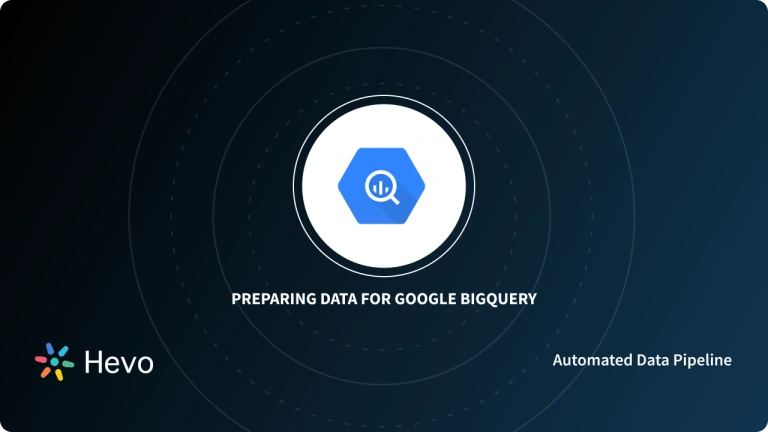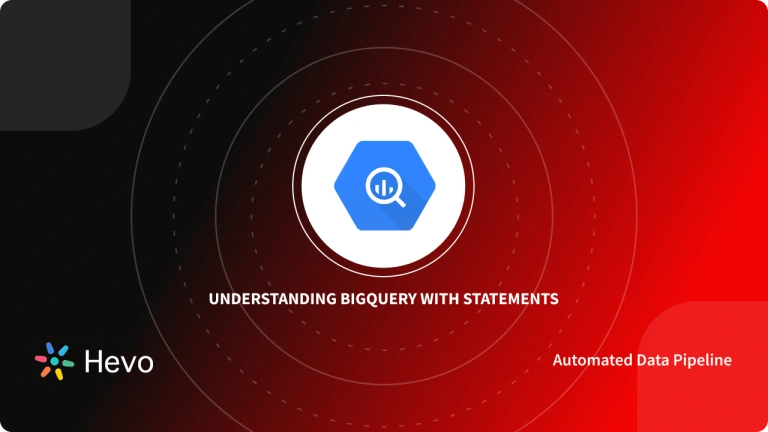More and more organizations are looking to unlock business insights from the data. However, it can be difficult to ingest, store, and analyze that data as it rapidly grows in scale and scope. Google’s enterprise Data Warehouse, BigQuery, has been designed to make large-scale Data Analytics accessible to everyone. When the size of recorded data grows to gigabytes, terabytes, or even petabytes, an enterprise surely needs a more efficient system like a Data Warehouse, to manage their vast amount of data.
This article will introduce you to Google BigQuery and will list the various features that make it so popular. It will also help you understand BigQuery Temporary Tables and will explain the methods to create them. Furthermore, the article will also describe the steps required to delete BigQuery Temporary Tables. Read along to learn more about this tool!
Use Hevo’s no-code data pipeline platform to effortlessly integrate your data in just a few clicks. You can extract and load data from more than 150+ different sources directly to your data warehouse.
Why choose Hevo?
- Provides real-time sync for better insights.
- Get 24/7 live chat support.
- Provides an automapping feature to automatically map your schema.
Experience why Ebury chose Hevo over Stitch and Fivetran to build complex pipelines with ease and after factoring in the excellent customer service and reverse ETL functionality. Try a 14-day free trial to experience hassle-free data integration.
Get Started with Hevo for FreeTable of Contents
Introduction to Google BigQuery
Google BigQuery is a highly scalable Data Warehouse and is well known for storing and querying data rapidly. It is a Cloud-based serverless Data Warehouse that allows ETL users to process data using multiple SQL queries. Google BigQuery supports real-time bulk data loading and uses the columnar format to store data.
Google BigQuery has the capability to handle massive amounts of data e.g., logs from outlets of retail chains down to the SQL level or IoT data from millions of utility meters, telecom usage, and vehicles across the globe. Powered by Google, BigQuery is certainly a Platform as a Service (PaaS) offering a fully managed Data Warehouse in a serverless architecture. Moreover, it is popular because it enables organizations to focus on Data Analytics instead of managing the infrastructure.
Key Features of Google BigQuery
The following features make Google BigQuery a popular choice in today’s market:
- Architecture and Scalability: Being a serverless architecture, Google BigQuery operates on the Cloud platform, thus facilitating the scalability of Data Analytics automatically.
- Decision Making: Google BigQuery allows the users to capture the best of the decision-making insights by forming and implementing Machine Learning algorithms using SQL. It offers real-time Data Analytics based upon high-speed streaming insertion API.
- Design: By design, Google BigQuery helps one avoid the data silo problem owing to the existence of individual teams in an organization, having their independent Data Marts as it offers cross-team communication concerning any of the Databases.
- Security: Owing to the integration of the subject tool with Google Cloud’s native identity and access management frameworks, the user can take control of the permissions and relevant access criteria for specific individuals, teams, or ventures thus enabling the safety and security of classified data to keep the classified all while still empowering the cross-team communications.
- Backup: Considering the essential nature of data for any organization, Google BigQuery offers automatic backup and restore options. It also keeps track of the performed changes on a 7-days basis so that comparison with previous versions can be done if necessary and recall any changes accordingly.
Understanding Google BigQuery Temporary Tables
Insights are extracted from the Google BigQuery Data Sets using SQL queries. It provides users with the flexibility to save the search results in BigQuery Temporary Tables. The essence of BigQuery Temporary Tables is that they cache the query results, can be named randomly and stored in a special dataset. The subject tables are primarily used to save the intermediate results, thus avoiding the hassle to save or maintain them in a given dataset. The visibility of all the BigQuery Temporary Tables can be achieved by the following sequence:
- Navigate to the BigQuery console.
- Click Query history, and select the query via which a BigQuery Temporary Table has been created.
- Move to the Destination Table row and click the Temporary Table option.
An important point to keep in mind about the sharing of BigQuery Temporary Tables is that they can neither be shared nor are they visible if the user employs any standard list or the given table manipulation frameworks.
Methods to Create BigQuery Temporary Tables
BigQuery Temporary Tables provide a lot of functionality and can be created by the following 2 methods:
You can use the TEMP parameter to set up a new Temporary Table as follows:
Part 1: The Syntax for TEMP Parameter
The following syntax can be used for creating BigQuery Temporary Tables:
Part 2: Use Case for TEMP Parameter
TEMP parameter is primarily a user-defined function (UDF) that can create temporary tables in the Google BigQuery. It gives users the flexibility to make customize tables for data visualization, as per the analytics requirements. More so, the use-case of TEMP is in the local temporary tables i.e., only visible to the current session.
Part 3: Example of Using the TEMP Parameter
A self-explanatory example of creating BigQuery Temporary Tables using the TEMP parameter is described as follows where a Temporary Table is also being used at a sub-query level.
-- Find the top 100 names from the year 2017.<br>CREATE TEMP TABLE top_names(name STRING)<br>AS<br> SELECT name<br> FROM `bigquery-public-data`.usa_names.usa_1910_current<br> WHERE year = 2017<br> ORDER BY number DESC LIMIT 100<br>;<br>-- Which names appear as words in Shakespeare's plays?<br>SELECT<br> name AS shakespeare_name<br>FROM top_names<br>WHERE name IN (<br> SELECT word<br> FROM `bigquery-public-data`.samples.shakespeare<br>);Method 2: Using the TEMPORARY Parameter
You can use the TEMPORARY parameter to set up a new Temporary Table as follows:
Part 1: The Syntax for TEMPORARY Parameter
The syntax for the TEMPORARY parameter is the same as that of TEMP and is given as follows:
Part 2: Use Case for TEMPORARY Parameter
Usage of TEMP and TEMPORARY parameters are the same, except for the fact that TEMPORARY is used for the creation of global Temporary Tables; these tables are visible to all the associated connections. Essentially, if a global Temporary Table is created in one session, it can still be used in the other sessions.
Deleting BigQuery Temporary Tables
Removing or deleting the BigQuery Temporary Tables is the mean by which users can keep the Database clean and clutter-free. There are certain methods available for achieving the subject target, but the most often used framework is the Drop Command in syntax.
Using the DROP Command to Delete Temp Tables
You can use the DRO command to delete a Temporary Table as follows:
Part 1: The Syntax of DROP Command
The syntax for using the Drop command in Google BigQuery is very simple and is given as follows:
DROP SCHEMA [IF EXISTS]
[project_name.]dataset_name
[ CASCADE | RESTRICT ]The notion of IF EXISTS is critical as sometimes, the given table doesn’t exist in the dataset and the system gives the following error.
Error: Not found: Table myproject:mydataset.mytable
Part 2: Use Case of the DROP Command
DROP function is primarily used to delete the entire Temporary Table and not some specific part of it. It is a critical part of Data Defined Language (DDL) in Google BigQuery. During data querying and visualization, BigQuery Temporary Tables are used to extract valuable insights; the redundant tables can be removed by using the DROP function. To delete specific rows or columns of the table, the DELETE command is used.
Part 3: Example of the DROP Command
The following query will delete the table named “mytable” located in the dataset “mydataset”.
DROP TABLE mydataset.mytable
Key Considerations for Temporary Tables in Google BigQuery
Although temporary tables play a key role in managing and processing large datasets, some key considerations can be followed to ensure the optimal performance in Google BigQuery:
- To write or save the results to a temporary table, a host of permissions must be granted to the user, which might include:
- Creation of new tables:
bigquery.tables.create- Filling of data into new tables, overwrite the associated data, or append the same :
bigquery.tables.updateData- Running a query task:
bigquery.jobs.create- BigQuery Temporary Tables are generally considered slow to query tables as they might entail a lot many records positioned in the database. Additionally, BigQuery Temporary Tables are primarily a view logic i.e., containing directions to the data and thus consuming more time.
- BigQuery Temporary Tables are short-lived i.e., they are session-based and information stored in them gets deleted once a session is aborted/closed, or completed.
- While creating a BigQuery Temporary Table, it is important not to employ a project or dataset qualifier in the table name. The table is already provisioned to be created in a special dataset.
Conclusion
Google BigQuery platform enables organizations to realize the real strength of Data Analytics while offering a variety of features to extract meaningful insights for optimal decision making. The BigQuery Temporary Tables are one such feature that provides users the autonomy to visualize the requisite data, without adding much burden on the storage side. The feature offers a lot of flexibility in terms of creating the data-filled layout, updating the information, and most importantly configuring the policies for automatic deletion of the table records.
Hevo is an intuitive no-code integration platform connecting over 150+ sources. Take a look at our unbeatable pricing plans and find the perfect one that works best for you and your business needs. Try a 14-day free trial and experience the features of the Hevo suite for yourself!
Frequently Asked Questions
1. What are temporary tables?
Temporary tables are the special tables of a database session. They can exist only during the lifetime of a session or transaction. They can be used to store intermediate results; their usage potentially minimizes complex queries, and their existence automatically terminates upon terminating the session or with the end of a transaction.
2. Does Oracle support temp tables?
Oracle supports temporary tables, which are technically called Global Temporary Tables, or GTTs. They allow the user to store data temporarily within a session, so the retention of the data is for the duration of the session or transaction only. In GTTs, structure is persisted while data can be private per session or transaction, so they are handy if used for managing intermediate results without crowding the database.
3. Is CTE faster than a temperature table?
It would also depend on the situation. For simpler queries, CTEs are faster as they execute in-line; however, for some complex queries or where the same data is needed more than once, temporary tables might be a better option, because they store data for reuse. At the end of the day, though, this will depend upon the context and the design of the query.










